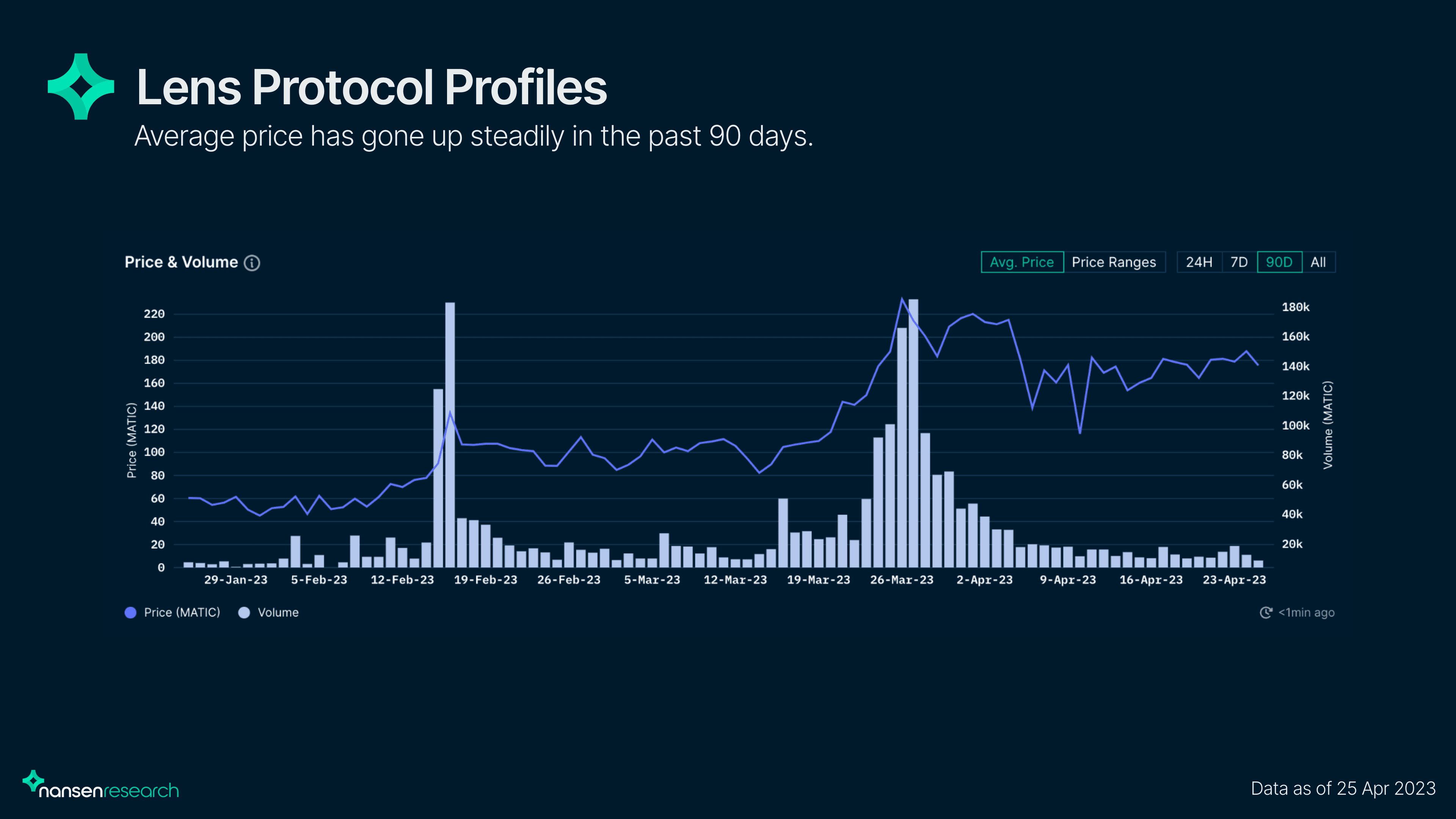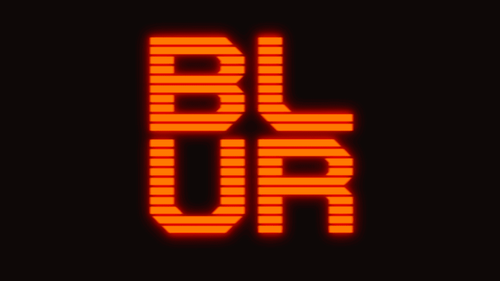Introduction
Social platforms are crucial to our daily lives as it is the main mode of communication between us and our networks. For many in the space, Twitter and Discord are two platforms that are indispensable due to the sheer amount of information and network effect enabled in these platforms. It is hard for users to give up these platforms given that they will lose their credentials and network, having to start from scratch on another. Hence, much of the space is highly vulnerable to these centralized platforms that could experience outages and interfere with how users interact with the platform without much resistance.
This is just one problem that decentralized social networks can solve. These networks aim to bring a new era with regard to how we can interact with others - through ownership and composability across apps.
What are Decentralized Social Networks?
The core feature of decentralized social networks is that user data is stored on the blockchain or independent nodes such that it allows users to own their data. Besides greater privacy, this gives more power to users in terms of their ability to control their own social graph, which is not possible with centralized platforms.
Traditionally, these platforms control access to the social graphs, as it is the key to their monetization strategy. With decentralized social networks, the focus has shifted to enabling creators to take control and implement their own monetization strategy.
The current landscape is already populated with many similar protocols aiming to solve the problems mentioned above. Apps such as Mastodon and Damus are a few of many that have gained traction in recent months. While these apps are not fully geared towards crypto-native individuals, it shows that overall interest in the decentralized social network space is rising.
Overview
Several social network protocols are already live or in the beta testing stage. Of all the protocols, the most prominent would be Lens Protocol - which is built by the Aave team. Other protocols such as Farcaster and Cyber Connect have also been growing.
Lens Protocol
Lens Protocol is a social graph protocol built on Polygon which aims to bring composability to social networks. Since its launch in May 2022, the protocol has attracted over 112k users (based on the number of wallets holding a Lens Profile NFT) and is still in its closed beta stage. The growth of the protocol may not be accurately reflected by the numbers, as access to the ecosystem is dependent on owning a Lens profile NFT. These NFTs have been distributed in small batches over time.
To access the ecosystem, users can buy a profile NFT on OpenSea. Average price of the NFTs have been trending upwards steadily since the start of the year, as airdrop rumors intensifies. The number of Smart Money holders have also been increasing, including wallets tagged as Airdrop Pro - suggesting that an airdrop could be imminent. Another way would be through Phaver, by collecting this SBT here. However, owning the SBT only puts you on the waitlist for a Lens handle and the selection process for addresses to be whitelisted are not spelled out. Speculation is that one’s activity on Phaver and the Clique dashboard heavily determines addresses that get chosen to mint a Lens handle.
Lens Protocol utilizes smart contracts and hence, profiles and actions from users are represented by NFTs. Data from each user’s publications, comments, and mirrors (boosting content) are stored within their profile NFT. When users follow someone, they will also be issued a follower NFT which is used to establish the connection between two users. Functionalities such as publications and comments come with a collect and reference module. This allows users to set a requirement for another user who wants to collect their publication or comment which is determined by the reference module. The follower NFT can also serve as a way for users to reward their followers by providing follower-specific actions to perform a certain functionality.
The presence of modules built onto functionalities affords developers a lot of freedom when creating their own app on Lens since these can be modified to fit the needs and targets of apps.
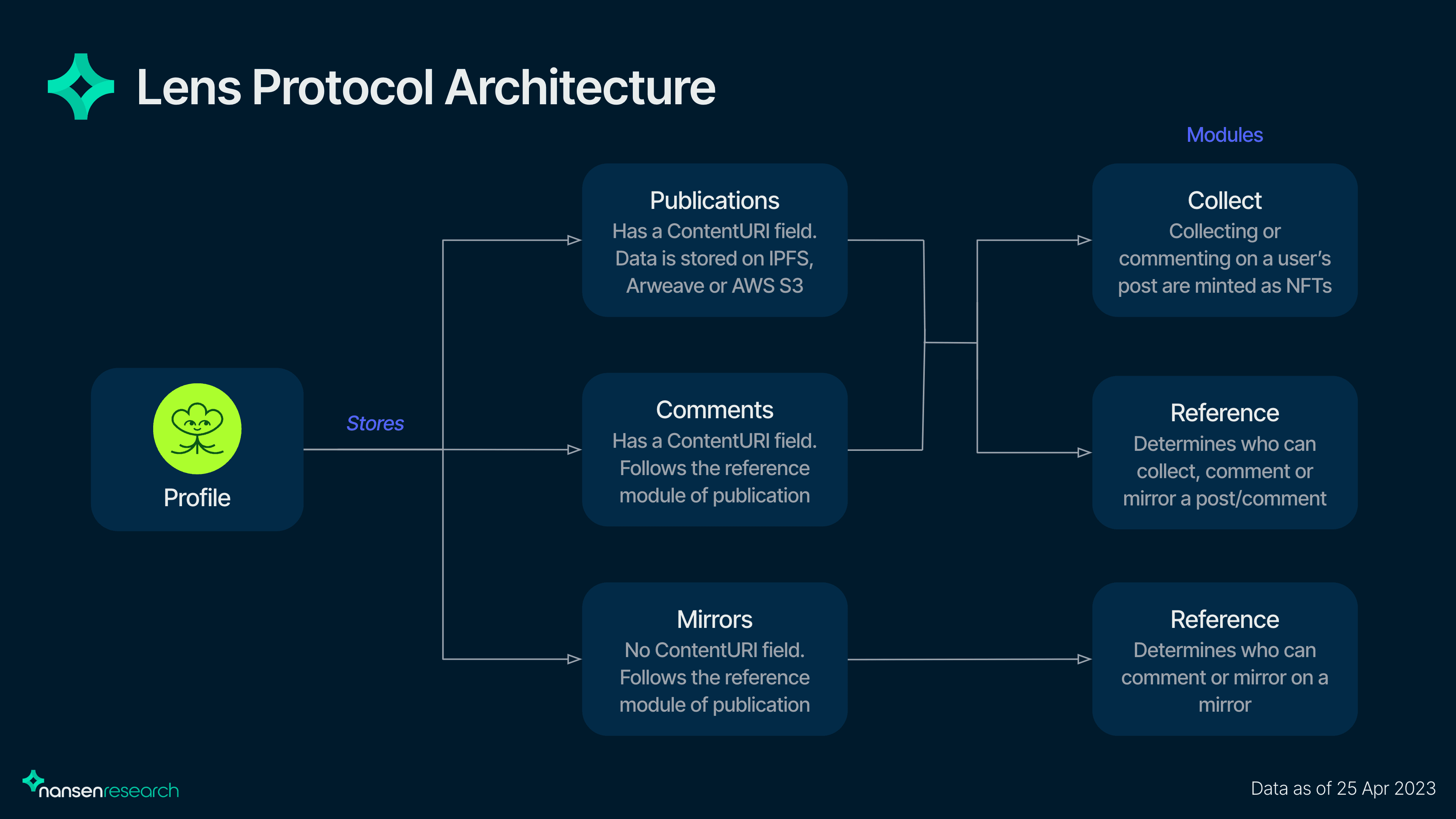
The ecosystem has grown significantly since it first launched, with over 40 applications building on it now. Apps which are more prominent are shown below. Most of the current use cases are centered around social media with apps such as Lenster, Lenstube, Orb, and Phaver having the most utilization at the moment. Lenster is the equivalent of Twitter in the Lens ecosystem and has seen the highest utilization among other apps with over 88k users that have created at least one post. Phaver is also one of the fastest growing apps on Lens with the number of weekly active users trending upward consistently since its inception. One of the distinguishing features of Phaver compared to other apps is that it is exclusively for mobile devices and allows users to connect without having a wallet. This feature has likely contributed to its growth and reach to a wider audience. It aims to be a super-app whereby it allows users to access content on Lens while earning rewards on the app at the same time. Users can earn Phaver points by creating content, liking, and sharing which many speculate will be determinant of its eventual airdrop value and it can be claimable for a Lens profile.
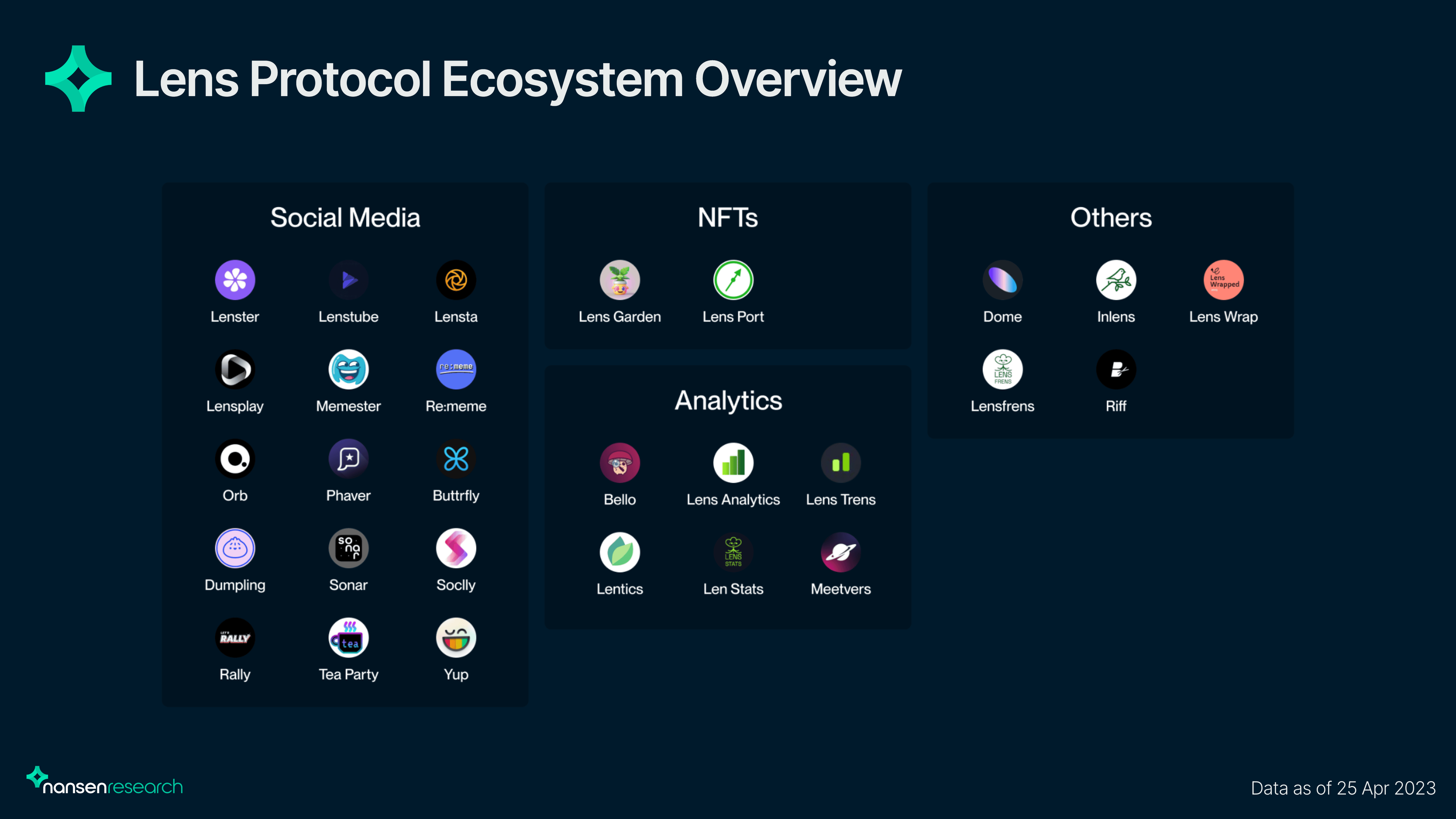
Lens stands to gain the most if social networks eventually integrate with DeFi as some form of reputation-gated DeFi. Stani (co-founder of Aave) has mentioned about integrating social credentials with DeFi activities before, signaling a possibility of such integrations when Lens goes live. Being a part of the Aave team lends them credibility as they have been one of the longest standing DeFi protocols in crypto. Besides, a smart contract social graph allows Lens to scale as integrations with DeFi protocols or DAOs can be easily deployed. Developers are also granted more freedom with the modules that Lens utilizes, which allows them to add customizable features through the reference module. Despite this, there has not been any stand out app in the ecosystem yet, as most are focused on decentralized social media. Therefore, while there is a strong network effect between the apps, there is not much between them yet to incentivize users to ‘stay loyal’ to one. The network is also only available on Polygon now, but can easily expand when it eventually opens up to the public. Notably, Lens had FTX Ventures as its lead investor in its seed round for an undisclosed amount, which was announced shortly before the FTX saga happened. Till now, the protocol has not made a statement about its investments from FTX.
Farcaster
Farcaster is a social graph protocol built on Ethereum that aims to ‘sufficiently decentralize’ social networks such that incentives are aligned between the network and its users. Access to the network is on an invitation-only basis, which is why the number of users is low at 12k, as compared to platforms like Lens. The team believes in curating the first 1 million users to maintain a certain quality on the platform, which seems to be working well in terms of user engagement.
Farcaster is network-based, which makes use of hubs to connect users to one another. When users create a profile, their Farcaster ID (fID) is stored on Ethereum. However, everything else related to a user’s data is stored on a hub instead, which is essentially a storage layer on top of a user’s fID. Each hub consists of several deltas - Casts, Reactions, Amps, Verifications, User Data, and Signers. Casts are equivalent to posts while reactions encompass likes, comments, and recasts (shares). Amps are a feature unique to Farcaster, whereby it allows users to boost a creator’s content temporarily. When users interact with a cast, it adds a new connection between users and the creator as updates are broadcasted to both parties in the peer-to-peer network. This connection is replicated across all interactions, which enhances the user's social graph as a new user can easily form a network by just interacting with one creator.
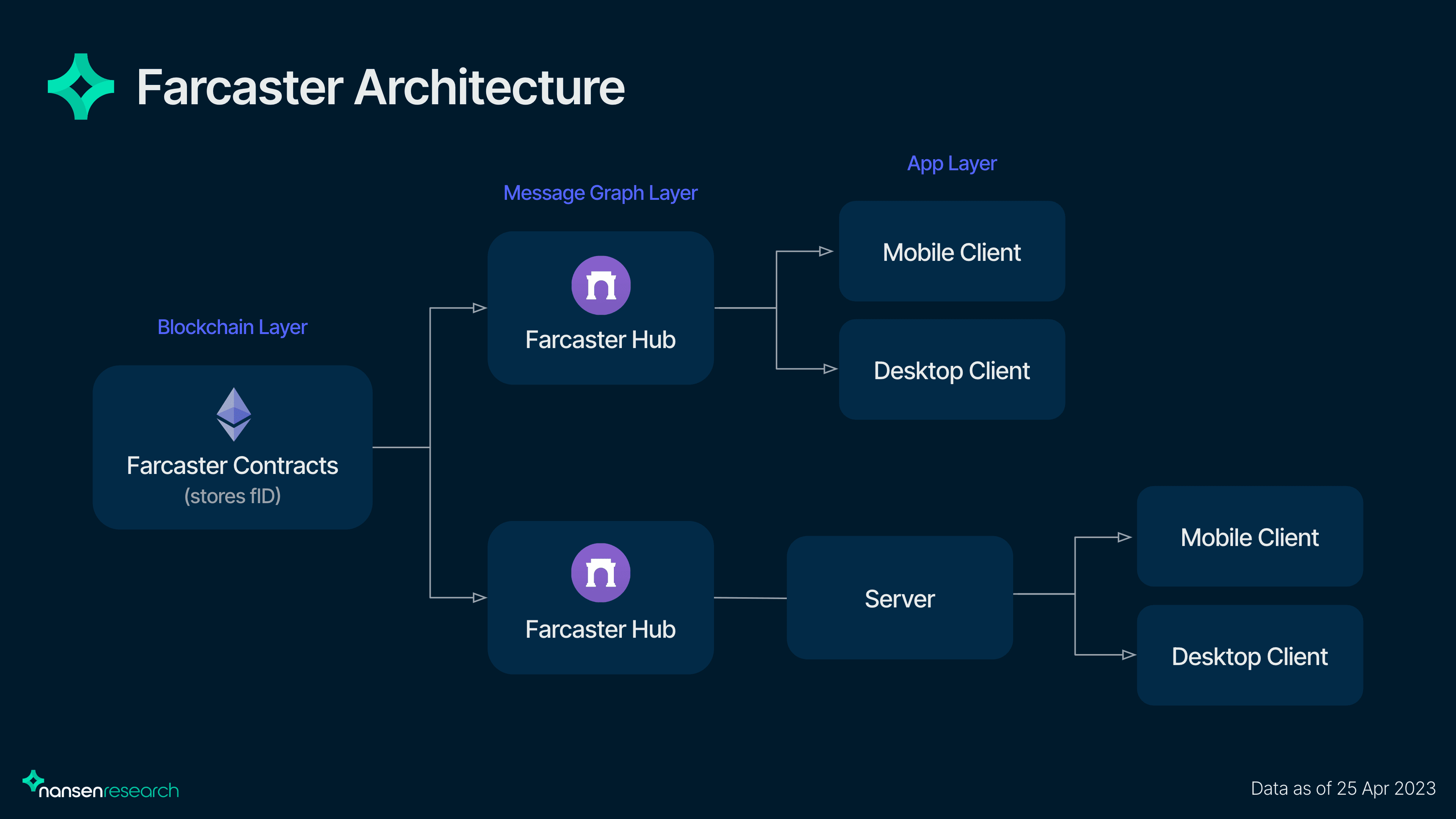
Other features include Farcaster Names (fNames) which is similar to ENS. One distinction is that fNames can be recalled by the governing body if there is a contention for the fName. This allows for verifiable identities which is not possible with ENS. Another feature would be verifications - two-way signed messages which allow users to connect their wallets to their fIDs since it is stored on the L1. Thus, users can integrate their NFTs and other assets into their profiles, making it a better user experience.
However, a downside to Farcaster is present in its Hub design. Although apps are incentivized to run their own hubs because of the ability to access and publish data firsthand, there may be instances where it does not make sense to do so due to costs.
As the network grows and receives higher usage, it becomes more expensive to run hubs as they require more storage. If that does happen, the network runs the risk of centralization issues with fewer operators. Operators also have the ability to restrict users on the network, similar to how Twitter can ban users at will. Thus, the team came up with boundaries which are placed on users’ data as each user has a designated amount of storage space and data is only kept for a year. The team mentioned the possibility of introducing pay-for-storage for users that require it, but ultimately it is still a problem given that centralized platforms can do way better in this realm. Therefore, centralization risks that persist in Farcaster’s current form causes it to be no different from traditional social platforms.
The Farcaster ecosystem is much smaller than Lens, and is still in its development phase. Some notable Farcaster clients are Warpcast, Discove, and Jam, of which Warpcast is built by the team at Farcaster themselves. Other apps building on top of Farcaster can be found here. Despite being behind in terms of front-end developments as compared to competitors like Lens, Farcaster has proven to be valuable with its curated community. Some protocols chose to launch their testnets or closed betas on Farcaster, which have been successful - signifying that keeping a small but strong crypto-native community has its perks. Daylight is a wallet management tool that allows users to keep track of actions they can perform on-chain - such as airdrop claims, voting on proposals, and mints. They launched their closed beta on Farcaster and it quickly gained recognition from the community and helped the protocol to improve their product based on the feedback from the community. Protocols such as Coherent and Perl have also launched testnets on Farcaster. Thus, being a part of the network allows for benefits such as early access to projects which would incentivize users to stay on the platform.
Farcaster is also moving towards its v2 mainnet - which will make it easier for developers to build new clients and iterate on existing versions through open-source libraries, which could incentivize more innovation on the platform. The number of hubs on testnet has been growing, which is a good sign of interest in the development of the platform. The team is currently shipping updates to the protocol, with the latest being URL and NFTs embeds for casts and reactions. Updates are slated to come every 6 weeks, with a free mint (just need to pay gas) coming along with every update. There are already several collections created by the founder of Farcaster, with all proceeds going to the DAO. There are no utilities to the NFTs as of now, but it may be a way to reward ‘early supporters’ down the road. The team behind Farcaster is Merkle Manufactory, which received $30 million in funding from a16z last year. Led by Dan Romero, who is the ex-VP of Coinbase - Farcaster is well-positioned to experiment and build the ultimate decentralized social network.
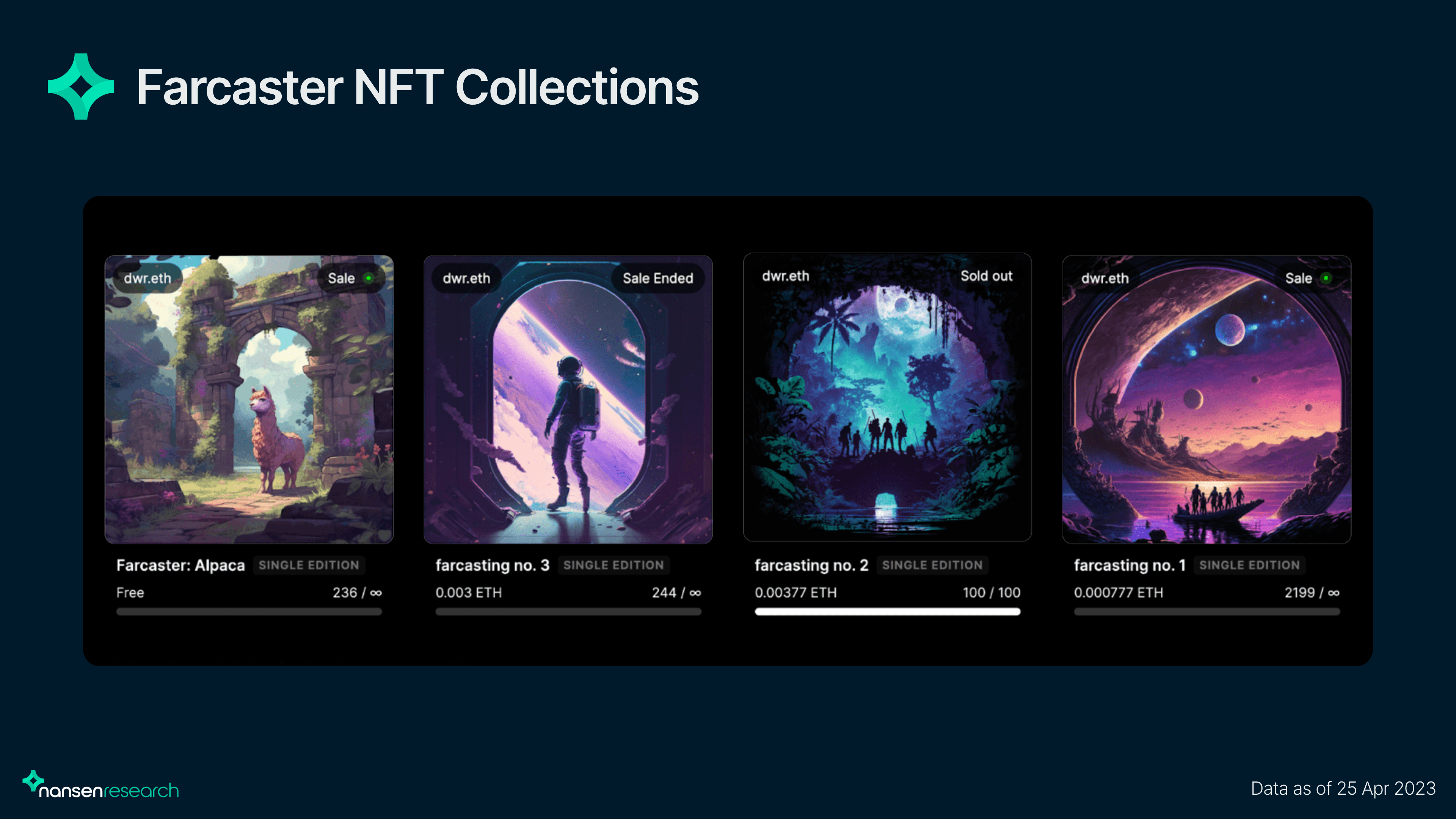
Cyber Connect
CyberConnect is a multi-chain social graph protocol built on BNB Chain, and is also available on BNB Chain, Ethereum and Polygon. The protocol has over 850k profile owners, with a spike in new profile owners in mid-March due to the Connected 2023 hackathon which allowed users to mint profiles for free. It allows new users to mint a free 12-character (or longer) ccProfile just by paying gas fees here (only mintable on BNB Chain). ccProfiles shorter than 12-characters come with a fee - ranging from 0.0333 to 33.333 BNB for 1-character profiles.
Similar to Lens, CyberConnect utilizes smart contracts - with users’ profiles and actions being represented by NFTs. Users will have ccProfiles which allows them to build their identity through NFTs, and credentials such as POAPs and SBTs. Users can create content or form connections which are also represented by NFTs. Users get to configure their SubscribeNFTs which allows for parameters such as pay-to-subscribe or hold-to-subscribe, creating a gated community. Similarly, users can customize these parameters for their EssenceNFTs, which allows users to collect the content posted by users. Thus, users are only issued NFTs if they choose to subscribe or collect the content from a creator. Otherwise, data on posts, follows, likes and comments are stored off-chain on Arweave or IPFS as the protocol believes it would be more efficient given that these actions would incur significant gas costs. Similar to Lens’ modules, CyberConnect has its own middleware layer that allows users to create constraints to issuing their SubscribeNFTs and EssenceNFTs.
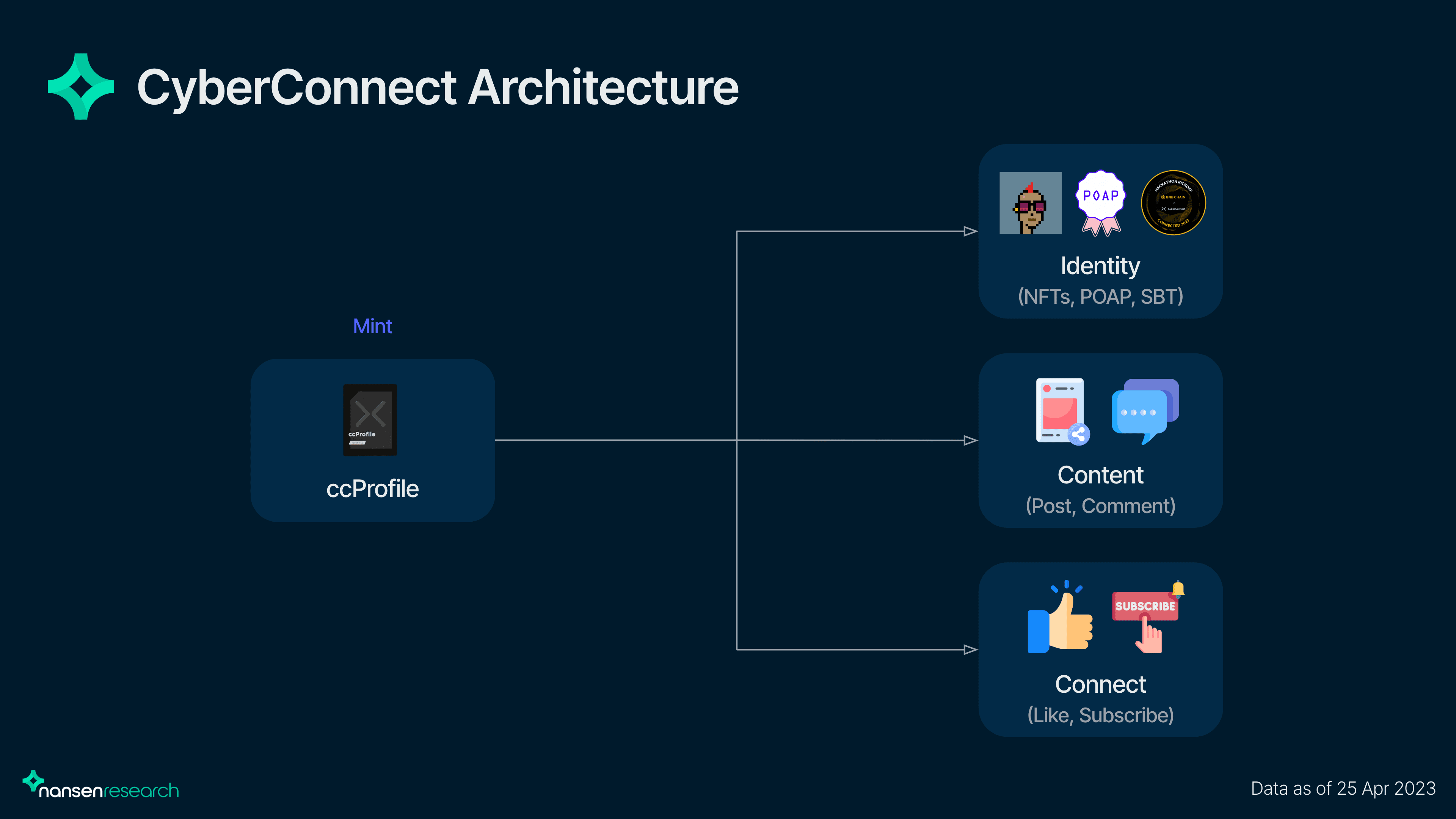
CyberConnect also has a variety of apps already live on their protocol - with the most prominent being Link3. The platform mainly focuses on providing greater functionalities to Web3 social events by having event planning tools, as well as a Web3 Status Token (W3ST) which are similar to POAPs. To collect W3STs, users can choose to attend any event from here. Users can also earn fan points from collecting W3STs, which will be accrued once they claim a fan pass here. These points can be used to join raffles for the Link3 Mystery Boxes and Mini Shards, which are speculated to be determinant of an allocation for the eventual token drop since these were also used to reward early users. The Mystery Boxes have a fixed supply, with 3.7k out of 9.8k claimed on Ethereum and 180 out of 200 claimed on BNB Chain. It currently has a floor price of ~0.35 ETH. The Mystery Boxes can be opened to obtain Shards which have a floor price of ~0.32 ETH. The utility of Mini Shards has yet to be announced but they are trading for rather low prices due to the unfixed supply. Overall, Link3 is a key app for CyberConnect, and it has been widely utilized among other crypto-native protocols as well. Besides Link3, notable ecosystem apps also include Phaver and Galxe - which are both established and vital to the growth of these social networks.
CyberConnect raised $15 million in a Series A round last year led by Animoca Brands and Sky9 Capital. The recent hackathon - Connected 2023, was also supported by BNB Chain. However, the ability to retain users is still a question given that weekly active users have dropped off significantly since the hackathon, suggesting that activity is largely only driven by incentives. The current airdrop narrative surrounding these social network protocols has probably affected the number of ‘true’ users as well.
There are many other protocols working on decentralizing social networks. While not as prominent as the ones mentioned above, some have interesting features that are not seen in other protocols. Other iterations of non-social graph protocols have also been growing rapidly, especially in the realms of social identity and creator monetization.
DeSo
- DeSo is a generalized L1 chain optimized for social apps, which has been live since 2021.
- The chain is currently running on a Proof-of-Work (PoW) consensus mechanism but is slated to move to Proof-of-Stake (PoS) soon.
- The chain recently switched from a UTXO to a balance model, helping to reduce storage costs - which was a blocker to scalability. This could allow for the possibility of full on-chain storage for all types of media, which is a step towards further decentralization.
- One interesting feature of DeSo is creator coins which are assigned to each profile. Users can purchase creator coins of a profile on a bond curve with DESO tokens through the Diamond app. This is a way for creators to reward their followers as when profiles become more popular, creator coins become more valuable and early supporters can benefit. Ownership of creator coins can also be a determinant of the level of access for users, and thus, the aspect of monetization is entirely up to creators to decide.
- The protocol raised over $200 million in funding in 2021 with investments from a16z, Sequoia, and Coinbase Ventures.
SO-COL
- SO-COL is a social network protocol that aims to help creators build and govern their own community easily.
- It is similar to how most social platforms work, but with the added functionality of token-gated communities through the use of NFTs. This allows creators to monetize through these NFTs that can be purchased by their fans.
- NFTs can be purchased using fiat currency and users can create an account without a non-custodial wallet, removing the barrier to entry for non crypto-native individuals to use the platform.
- The protocol is backed by Animoca Brands, Mechanism Capital, Defiance Capital and recently received $4.5 million in funding from DWF Labs and Blockchain Capital.
- Looking at the chart for SIMP, the token has been on a downtrend and is currently down over 90% from its ATH on February 15. The SIMP token is used to incentivize users to use the platform, and will also be used for governance and staking to access activities etc.
Social integrations into NFTs or DeFi protocols have also been proliferating. Memeland is building its own social platform for its holders. STFX, Perpy Finance, and NestedFi have also incorporated social aspects to trading. Furthermore, recent raises into decentralized social apps also show that there is still interest and potential in this market to grow. Some of the raises that happened early this year include:
- Zion
- a decentralized social platform on the Bitcoin lightning network raised $6 million, bringing its valuation to $53 million.
- Towns
- a decentralized group chat protocol built by HNT Labs raised $25.5 million in a round led by a16z. The founder was previously the co-founder of Houseparty.
- Sending Labs
- a developer infrastructure for social protocols raised $12.5 million led by Insignia Ventures Partners, MindWorks Capital, and Signum Capital.
- SpaceID
- a hub for Web3 digital identities raised $10 million in a strategic round led by Polychain Capital and dao5.
- Port3
- a Web3 identity management tool raised $3 million in a round led by Kucoin Ventures, with other investors such as Jump.
Overall
Among all the protocols mentioned above, Farcaster arguably holds the most potential for social graph protocols in the crypto space. Farcaster has demonstrated its value of having a crypto-native and gated community and can use it as leverage to attract like-minded individuals which will make the network effects even stronger for the protocol. It helps to maintain the quality of the community which would be a key differentiator with current platforms like Twitter. While centralization is a serious issue, it likely will not concern most end-users as the incentive for them to switch over would not be decentralization. The eventual move to v2 mainnet for Farcaster would likely attract more developers to build on the protocol as well. While there is no exact date as to when that would happen, updates from Twitter and Github repositories seem to signal that it could be soon.
Lens Protocol seems to strike a balance between catering to both crypto-native users and non crypto-native users, similar to CyberConnect. Phaver, which is live on both protocols, is positioned to capture both groups of users through simplifying the onboarding process - having an option of email sign-up that caters to non crypto-native users. CyberConnect also has a strong suite of apps outside of the social media realm such as Link3 and Huddle01 which are good alternatives to its centralized counterparts. However, there are simply no incentives for users to switch over at the moment. CyberConnect’s fan points and W3STs are currently a good way to attract users, but most are likely incentivized by the airdrop rumors. Thus, real growth and adoption of these protocols is still an uncertainty. Introduction of a token may be a catalyst in the short term, but will likely result in mercenary activities and become detrimental to the protocol instead.
Risks
While the promise of decentralized social networks are ideal, current iterations of it would come with a lot of risks and trade-offs as compared to utilizing traditional social networks.
- Decentralized social networks do not have sufficient network efforts to prompt users to switch over from centralized platforms.
- The current number of active users for protocols such as Lens is likely skewed due to users airdrop farming.
- DeSo has been live for over 2 years but has yet to see numbers comparable to traditional social networks.
- Current processes are too complicated for most users to reach mass adoption.
- Creation of non-custodial wallets and minting or buying NFTs in order to use these protocols would be a barrier to entry for non crypto-native users.
- Farcaster requires users to use a private key to sign off on messages and transactions, which is likely foreign to most users.
- The promise of decentralization is also largely unfulfilled yet, since many of these protocols still rely on centralized entities for storage or to regulate activity on the protocol.
- Centralization risks on protocols such as Farcaster causes it to be no different from traditional social platforms now.
- Lens Protocol and CyberConnect also utilize centralized entities such as AWS to fulfill data storage needs.
- Full decentralization also comes with inherent risks, with governance being an area of possible exploitation through manipulation by large players.
- Situations whereby whales dictate the outcomes in proposals for DeFi protocols can similarly happen in social networks protocol. Thus, these risks become apparent as whales can technically ‘control’ the network depending on the powers given to governance.
- The introduction of tokens could also cause issues if financial incentives are tied to social activity, as it adds another layer of complexity for protocols to deal with when the token does not perform well.
- Protocols like Deso and SO-COL utilize their tokens to reward users which introduces a mercenary aspect as it attracts ‘farmers’ who enter and leave once rewards are no longer attractive. This creates extra challenges to achieve real growth for the platform.


